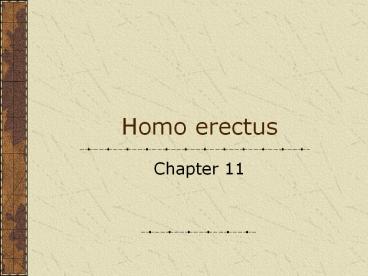Homo erectus - PowerPoint PPT Presentation
1 / 18
Title:
Homo erectus
Description:
Fossil sites from various areas in Africa, Asia and Europe. Homo erectus ... Nuchal torus. Sagittal ridge (keel) Broad at the base. Shovel shaped incisors ... – PowerPoint PPT presentation
Number of Views:1122
Avg rating:3.0/5.0
Title: Homo erectus
1
Homo erectus
- Chapter 11
2
Objectives
- Assess physical characteristics regarding brain,
body size and cranial morphology - Fossil sites from various areas in Africa, Asia
and Europe
3
Homo erectus
- 1.8 m.y.a. to 250,000 y.a.
- Migrated out of Africa
- Two species? or none?
- Direct line with modern homo sapiens
4
Homo erectus
- New grade of evolution
- Similar adaptative pattern
- European/African sites Homo ergaster Asian
sites Homo erectus
5
Pleistocene 1.8 m. to 10,000 y.a.
- Ice Age
- Hominids leave Africa culture used to adapt to
environmental changes
6
Brain and body size
- 750 1250cc with a mean of 900cc (25 to 40)
- Body size larger and more robust than H.habilis
- Cranium changed to compensate for an increase in
brain/body size - Reduction in tooth size
7
Shape of the cranium
- Overall pentagonal shape
- Large brow ridges
- Low forehead
- Nuchal torus
- Sagittal ridge (keel)
- Broad at the base
- Shovel shaped incisors
8
Shovel-shaped incisors
9
Postcranial bones
- Nariokotome WT15000 (West Turkana) 1.6 mya
- Vertebral column
- Pelvic brim
10
Dmansi 1999
- Republic of Georgia
- 1.7 mya Homo erectus in Europe
- Primitive, small-brained hominid with large
canines. - More similar to early Homo
- Question Was Homo erectus the first hominid to
leave Africa?
11
Java (Indonesia)
- Eugene Dubois (1858-1940)
- Pithecanthropus erectus
- Skull cap and femur
- Sangiran (1.6 mya), Ngandong (50 to 25,000 y.a)
12
Zhoukoudian (China)
- 500,000 to 200,000 y.a.
- 40 individuals (male and female)
- High infant and young adult mortality
- WWII - original homo erectus fossils were lost
- Other chinese sites Lantian (650,000 ya), Hexian
(250,000 ya)
13
Zhoukoudian - culture
- Inhabitants of the cave or scavenger deposits?
- First controlled use of fire?
14
Acheulian stone tools
- Zhoukhoudian increase in sophistication of tools
- Bi-face
15
East/South Africa
- East Turkana ER3733, 1.8 m.y.a
- Olduvai OH9, 1.4 m.y.a
- South Africa - SK 15, Swartkrans 1.3 to 1.0 m.y.a
- Associated with the controlled use of fire
16
Acheulian stone tool culture
- Scrapers, burins, retouched flakes and awls
- Africa, Southwestern Asia and Europe
17
Trends in homo erectus
- Gradual increase in cranial capacity, decrease in
robust body form, more protrusive nose. - Gradual sophistication of the biface and the
Acheulian tool assemblage. - Potential hunter and scavenger
- Gathering of wild plant foods
18
Summary
- First out of Africa?
- Distinct cranial morphology
- Acheulian tool kit bi-face
- Control of fire?
- Culture (adaptative strategy)































